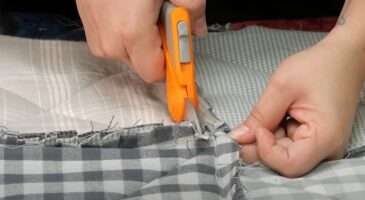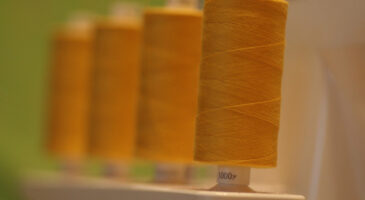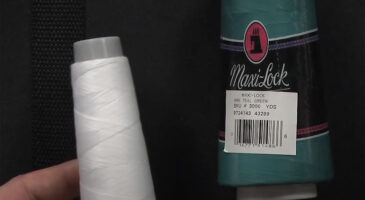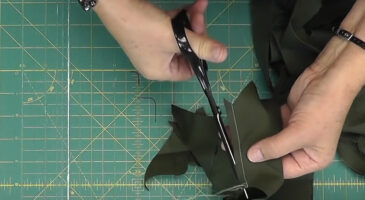Overlock is a stitching technique that involves combining a zigzag and a straight stitch. With overlooking, you can either sew forward or backward in a straight line; however, it sews a zigzag between each set of straight stitches.
The purpose of overlocking is to give handmade garments a professional finish.
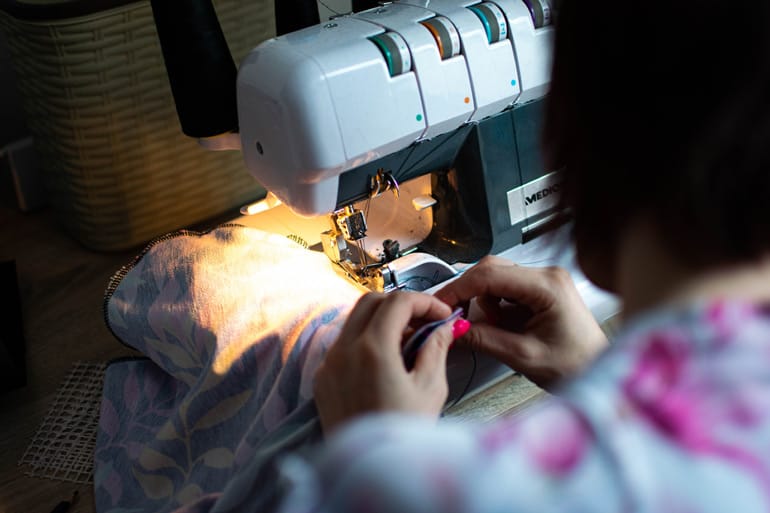
Normally, there’s a sewing machine specially designed for overlocking, but overlocking machines are very expensive; hence, getting one can be an uphill battle for a striving tailor or fashion designer. This is why it is not unusual to see people ask questions like, can you overlock on a normal sewing machine? How do you overlock a regular machine? You will get to know all these in this article.
Can I do overlock on a normal sewing machine?
Yes, overclocking can be done on regular sewing machines. Although we have overlocker machines that do overlock, however, in the absence of this specialized machine, overlocking can also be done either by hand or on a regular sewing machine.
All you need to get the same edging as that of an overlocker is an overedge foot, also known as an overcast or overlocking foot.
How do overlock machines work?
Unlike the normal sewing machine, which uses a bobbin and top thread to form stitches. An overlock machine work by using needle threads and loopers to make overlocking stitches.
How to overlock on a normal sewing machine
After attaching an overlock or overedge foot to your regular sewing machine, you can follow the guide below for instructions on how to overlock with a regular sewing machine.
- Have the edge of your fabric lined up with the overegde’s guide bar, and start sewing as slowly as you can to make it easier for you to control the machine.
- Stop between a few stitches if your seam is curved to rotate slightly and realign the fabric edges. Note that this method may take more time, but later, you will come to realize it’s worth the effort.
- After sewing, instead of cutting the fabric the regular way by pulling it to the left, free the fabric from the sewing machine by pulling it towards the back of the sewing machine. Doing this will prevent your fabric from getting mutilated by the small bar underneath the overlock foot.
- Overlocking lightweight fabrics like chiffon, voile, or organza can be difficult, and if the fabric is so thin, it can get pulled easily into the feed dogs and chew up. Therefore, a better way to deal with such fabric will be to jointly overlock the seam allowance as a single layer before pressing them to the side. Alternatively, you can also apply stabilizing agent like tissue paper under your seam as you sew.
Can you use overlock thread on a normal sewing machine?
Yes, you can use overlock thread on a normal sewing machine, but it is not advisable. You can very well run an overlock thread on a regular machine, and trust me; it is going to do the job that you want it to.
However, because overlock thread is thinner than the regular sewing machine, and if used instead of the regular thread on a normal sewing machine, the seam made on the fabric using the thread will easily unravel. And it’s the reason why it is not advisable to use them on a regular machine.
What is the difference between overlock and serger?
- Compared to the serger machine, which is difficult to operate due to its complicated spaces for colorful spools, looper, and knife, the overlock is much easier to operate.
- Serger can be used to make several sewing options and can perform multiple tasks at once. Whereas overlock can only be used to perform limited tasks due to its limited spool of thread
- In terms of stitch width, a serger can complete more stitch per inch in comparison to how many stitches per inch an overlock completes, and that is why stitches made by a serger are usually stronger.
- In terms of price, serger machines are more expensive than overlock machines, and this is because serger can be used for multiple functions.
Can you do an overlock stitch on a regular sewing machine?
Yes, you can do overlock stitch on regular sewing machines. Some regular sewing machines can perform the specialized task of overlocking.
These machines can also be used to perform other tasks like hemming and edging. With that said, you should know that in most regular machines, overlocking is a purchased added feature.
Can I overlock without an overlocker?
Yes, you can overlock without an overlocker. Overlockers are designed for the single purpose of overlocking to give fabrics a professional finish. If you do not like this machine, there are several other alternatives. You can make overlocking by hand or by using an overedge foot.
Can you overlock by hand?
Yes, you can overlock by hand. One of the alternatives to using an overlocker to make an overlock is by hand. This method is also very effective, only that it is time-consuming and can be a little challenging.
What do you do if you do not have an overlocker?
If you do not have an overlocker, you can also make overlocks with your hands or your regular sewing machine. But before you can overlock with your normal sewing machine, you have to make use of an overlock foot or an overedge foot.
Do I need an overlocker?
No, you do not need an overlocker. Although adding an overlocker to the collections of your sewing equipment wouldn’t be a bad idea, in some cases, it can amount to a waste of resources. This is because of several alternatives to perform their function.
A good example of this is using a serger machine that can sew and perform overlock simultaneously or using an overlock foot with the regular sewing machine.
What is the best overlocker for a beginner?
The best overlocker for a beginner is the Jaguar starter 098. This overlocker is best for beginners because of the following reasons.
- It is very easy to thread
- You can stitch with 3 to 4 threads.
- It has rolled hem setting.
- You can control the number of machine stretches.
